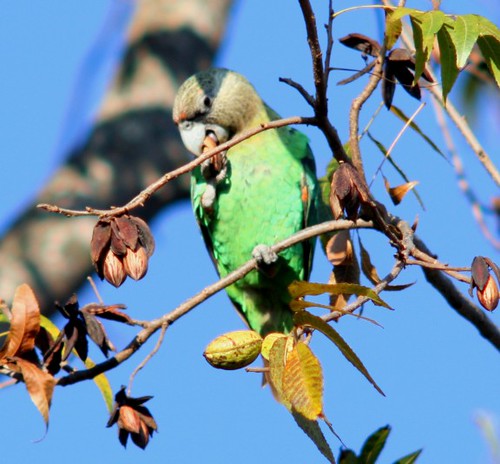Saving the Cape parrot
 Tuesday, March 27, 2012 at 4:00
Tuesday, March 27, 2012 at 4:00  Cape Parrots are under threat from poachers, loss of habitat, and parrot beak and feather disease. Photo: Steve BurtonA COMMUNITY project in a mountain village is helping to create jobs at the same time as protecting a rare forest bird. The R1.6-million Cata Eco-Tourism Development Project was established through an agreement between the EU and the office of the premier in the Eastern Cape, to help the people of Cata, a village near Keiskammehoek, at the foot of the Amatola Mountains.
Cape Parrots are under threat from poachers, loss of habitat, and parrot beak and feather disease. Photo: Steve BurtonA COMMUNITY project in a mountain village is helping to create jobs at the same time as protecting a rare forest bird. The R1.6-million Cata Eco-Tourism Development Project was established through an agreement between the EU and the office of the premier in the Eastern Cape, to help the people of Cata, a village near Keiskammehoek, at the foot of the Amatola Mountains.
The project is built around the Cape parrot, of which there are only about 1000 adult birds left, and the indigenous Afro montane forest, and particularly the yellowwood trees, on which these birds rely.
The details of how the project works, and what the aim is, were presented at a Birdlife South Africa conference in Port Elizabeth last week.
The funding over two years of f R1.6-million is being channeled through the Sustainable Rural Development in the Eastern Cape (Suradec) programme and is being managed on the ground by Birdlife South Africa.
The project was formulated in consultation with the community in line with the realisation that eco-tourism is the most suitable industry for the area, which has rich biodiversity and key value as a regional water catchment, project spokesman Nick Theron explained.
"About 30 residents of Cata are working on the project and the money they bring in, once it evolves into a fully-fledged enterprise, should sustain many more people through the households they support.”
The community was already conservation-minded in that they harvested food from the forest and water from the mountain streams and grazed their cattle in adjacent grassland, and they understood that these resources were not infinite, and there was a need to conserve them, he noted.
"But a way had to be found to enhance this conservation approach, and at the same time help them to get more out of their amazing natural environment.”
Aided by Theron and his Birdlife team and consultants from the EU and government, the community created three hiking trails, comprising a total of 12kms.
At the same time, community participants were trained as bird guides, and in business skills, focusing on how to establish and manage a sustainable eco-tourism company – with a very special brand.
Cape parrots are restricted globally to a thin band of mountain forest stretching from KwaZulu-Natal to the Eastern Cape. Once, this forest was contiguous, but now it is fragmented and degraded in many parts.
The dominant tree in the forest is the yellowwood and the Cape parrot relies heavily on these trees, eating their fruit and nesting in "snags” or hollows in the trunks of dead yellowwoods, Theron said.
"So the threat to the survival of the Cape parrot is direct and indirect.
"Poachers trap the bird for the pet trade, and there is a beak and feather disease called PBFD. And then there is the pressure on these forests from commercial forestry, from illegal logging and from clearing of forest to allow for expanding agriculture.”
So the aim of the project is to create a positive reinforcing cycle where the more the value of the birds is recognised, the more effort will be put into protecting this habitat, which will allow the Cape parrot population to grow, which will attract more tourists and so on, he said.
"The aim is that the community will improve their controls on firewood collection and harvesting of plants, for instance, and that they will start to clear alien invasive wattle. ”
This work can dovetail with other Cape parrot conservation groups which are putting up nesting boxes and planting indigenous forest trees in an effort to gradually restore and expand the forest and improve the birds’ breeding success.
A marketing plan focused on getting the word out about the unique Cata Cape parrot guiding attraction has already been devised with input from all the role players, and a first step will be to implement this plan.
If the project does transform into a successful enterprise, Suradec will be looking to duplicate it at other points along the ribbon of mountain forest, with other local communities.
In towns like Alice and King William’s Town, especially in the Summer-Autumn months, large flocks of Cape parrots are sometimes spotted flying overhead, giving the impression that they are plentiful, Theron noted.
"But this is a false perception, and in fact that flock often comprises all the birds in that area, and they are on their way to another pocket of forest many kilometres away, because their yellowwood fruit diet has run out locally.”
Tourists can either stay with Cata residents in their homes, or in purpose-built chalets. Mountain bikes are available to complement the main Cape parrot excursion offer.
 Poicephalus robustus - Cape Parrot | in
Poicephalus robustus - Cape Parrot | in  Conservation,
Conservation,  Eco-tourism
Eco-tourism 
